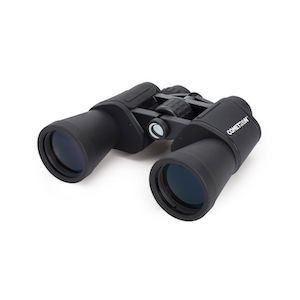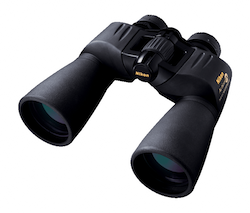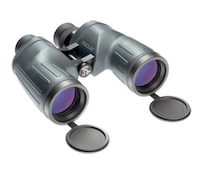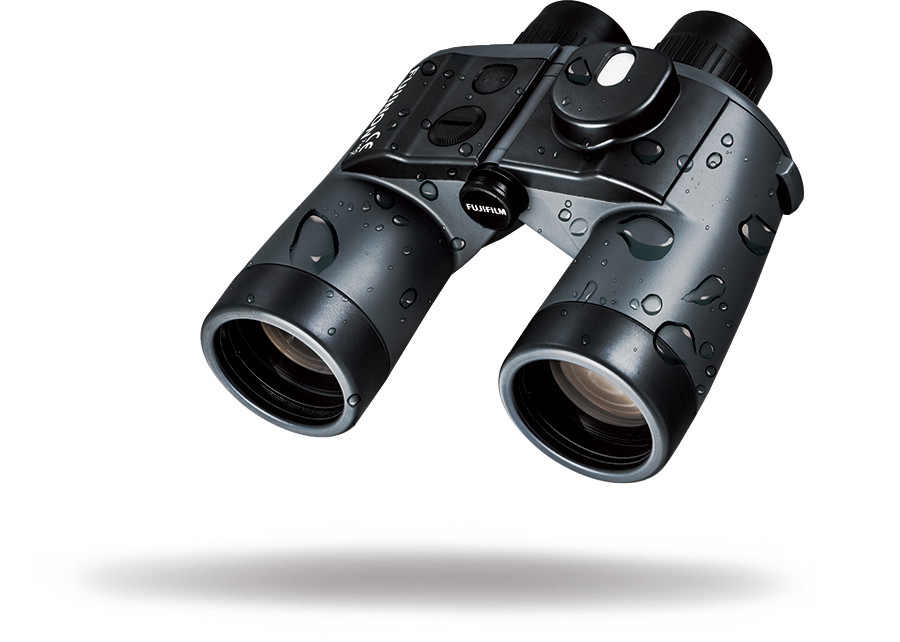For astronomy beginners or those on a tight budget, a pair of 7×50 astronomy binoculars could be the perfect option to get you started with observing objects in the night sky such as the Moon, star clusters, and nebulae. 7×50 binoculars have been the standard spec for militaries, law enforcement, and hunters since World War II, and it’s no coincidence that they tend to be a great pick for astronomy as well. Their 7mm exit pupil maximizes the brightness of terrestrial objects at night and provides the brightest images of extended objects like nebulae (though it amplifies the sky glow from the Moon or city lights), while 7x magnification is easy for almost anybody to hold steady, and the tolerances required to make a good pair are fairly low. As the all-purpose binoculars market is much larger than the telescope market, and smaller binoculars do not require a mount or tripod, they are remarkably cost-effective.
Additionally, 7×50 binoculars are usually fairly easy for children to use, whereas they may be completely unable to hold 10x50s steady. 7x50s typically provide a slightly wider field of view than 10x50s as well, though there are some drawbacks and reasons you might want to go for a pair of 10x50s instead, which will be discussed below. Our binocular rankings compare both options side-by-side as well.
Handheld 7×50 binoculars provide a true field of view similar to a typical 6-10x finder scope, making them valuable for reference or practice when attempting to locate a new celestial object with your telescope for the first time if it uses a magnifying finder of some sort. However, using both eyes is more comfortable and provides a significant brightness boost compared to using a single-eye telescope. This puts a pair of 7×50 binoculars on par with a 60-70mm finderscope or telescope in terms of overall light-gathering capability.
7×50 or 10×50?
The majority of 7×50 binoculars are easier to hold steady than 10x50s and provide a wider true field, usually 7 degrees or greater. However, this translates to a narrower apparent field than most 10x50s can easily squeeze out; a 7-degree true field at 7x translates to a 50-degree apparent field, whereas it would be 70 degrees at 10x. This can feel less immersive. Additionally, the exit pupil of a pair of 7×50 binoculars is 7mm in diameter, as opposed to 5mm with 10x50s. Almost everyone’s pupils can dilate to 5mm, but older people might have trouble getting their eyes to dilate beyond 5-6mm and thus will experience vignetting with 7x50s. Similarly, during the daytime, the view through a pair of 7x50s will have some odd-looking vignetting. Under light-polluted skies, the larger exit pupil can also lead to a brighter sky background, leading to less detail in faint deep-sky objects, which will appear more washed out against the brightly lit sky with 7x50s than 10x50s.
The stability of 7x50s in almost anyone’s hands is by far the best reason to go with them over 10x50s; many of our readers are likely to live under light-polluted skies where the brighter background alone is often a huge disadvantage. However, we encourage you to peruse not only our selections here but also our choices for the best 10×50 binoculars and our binocular rankings page to make an informed decision.
Recommended Best 7×50 Binoculars
Under $75 – Cheapest – Celestron Cometron 7×50

- Extremely low price
- Fairly wide field of view
- Lightweight
The Celestron Cometron 7x50s are an affordable 7×50 binocular option that still allows for impressive views, making them our top choice in their low price range. They feature a 6.8-degree true field of view, which is pretty respectable for this price point, and are sharp at all but the outermost edges. However, due to their low price, some quality compromises are unavoidable, such as vignetting of the aperture due to the use of inexpensive BK-7 prisms and basic, less efficient coatings on the optics, which further restrict light-gathering ability. Furthermore, these binoculars lack significant water resistance, and the eyepieces can sometimes get tilted if you press your head into them too hard, blurring the view.
What we don’t like:
- Low-quality, undersized BK7 prisms and simple coatings reduce performance significantly
- Annoying issues with eyepieces shifting around when used
- Generally low build quality
$75-$125 – Best Value – Orion Scenix 7×50

- BaK4 prisms and fairly good optical quality
- Very wide field of view
- Lightweight (28 oz)
The Orion Scenix 7x50s feature high-quality BAK-4 prisms and a fairly wide true field of 7.1 degrees. The eye relief is comfortable for eyeglass wearers, but the eyecups are standard roll-up rubber rather than twist-up. The biggest drawback of the Scenix 7x50s is their lack of waterproofing or water resistance, so users must exercise caution in damp conditions. They’re also not very well-armored in general. If you plan to use your binoculars for bird-watching and general outdoor purposes, a more rugged or less expensive pair may be more suitable.
What we don’t like:
- Sharpness drops off towards field of view edges
- Eyecups are hard to roll up and down
- Kind of fragile
$125-$175 – Nikon Action Extreme 7×50

- BaK4 prisms
- Very good optics
- Waterproofed polycarbonate body, a bit more durable than the usual
- Comfortable twist-up eyecups
The Nikon 7×50 EX Extreme binoculars are an excellent choice if you want binoculars suitable for both astronomy and daily outdoor use. These binoculars are waterproof and feature a polycarbonate body that is easy to grip and offers additional protection from accidental drops compared to a standard rubber coating. However, they only provide a 6.4-degree true field, which is a bit narrower than our other recommendations and not any wider than that of the 10×50 EX Extremes. This translates to a 43-degree apparent field, which is far from immersive and can feel arguably claustrophobic. At 35 oz, these are also far from the lightest weight option for 50mm binoculars available. The good news is that the 17mm eye relief of these binoculars is plenty for glasses wearers, and these binoculars feature twist-up eyecups.
What we don’t like:
- Kind of expensive
- Narrow field of view
- A little heavier than other options
$175-$225 – Best Performance – Orion Resolux 7×50

- Sharp optics
- BaK4 prisms
- Wide 7.5-degree field of view
- Long 20mm eye relief
- Completely waterproof
The Orion Resolux 7x50s are a beefy, fully waterproof option for 7x50s with a sharp 7.5-degree true field, 20mm of eye relief, and, of course, BaK-4 prisms. They also feature individual eyepiece focus adjustment rather than center focus, – not as quick for terrestrial use but ideal for crisp astronomical views. However, the eyecups are roll-up and thus difficult to actually put down to utilize the full 20mm of eye relief that these binoculars theoretically provide, while the 55 oz weight of these binoculars combined with their bulky frame can make holding them comfortably for extended periods a bit of a chore.
What we don’t like:
- Unusually heavy
- Individual eyepiece focus is not the most convenient nor intuitive
- Front lens caps are permanently attached
- Kind of bulky
$175-$225 – Best Quality – Fujinon Mariner 7×50

- Extremely high-quality optics with BaK4 prisms
- Wide 7.5-degree field of view
- Completely waterproof and even able to float
- Very durable
The Fujinon Mariner XL 7x50s are Fujinon’s entry-level marine binoculars. Their other products are wildly expensive. With a 7.5-degree true field of view, these are tied with the Orion Resolux 7x50s for being the widest-field pick of any of our top 7×50 binocular recommendations. While boasting sharp optics, they do start to lose sharpness about 3-3.5 degrees from the center of the field of view, but most of our other 7×50 recommendations’ field of view outright stops at around this point. At only 29 oz, these are also fairly light considering the features they include. And with 18mm of eye relief, they’re also fairly comfortable to use, even if you have to keep your glasses on.
What we don’t like:
- Expensive
- Individual focus eyepieces may not be the most intuitive
- Outer edges of field of view are not completely sharp
